
The heartland of the Russian nation, as seen through the Gagarin cult, was not in Moscow but in Gagarin’s hometown of Gzhatsk. Renamed “Gagarin” after the cosmonaut’s death in 1968, the town is a typical Russian provincial backwater. In the words of one ode to Gagarin entitled, “The Native Side of Things,” the cosmonaut grew up among vast “expanses of flax and thick meadows of clover,” surrounded by honeybees and butterflies, yet at the center of the country. Rivers and rivulets flowed northward to Leningrad and southward “to the Mother Volga, and then meandered their way to the little father (batiushka) Dnieper.”[1]
That ode to Gagarin’s provincial origins — as a banner of the cosmonaut’s authenticity — connected him with earlier Soviet heroes. For example, the provincial Soviet hero Pavlik Morozov, according to Catriona Kelly, was “imported from the periphery, repackaged, and then exported for the edification of Soviet provincials…The legend came at once from the ideological heart of the country, and from the muscle and bone of its provincial everyday.” (Catriona Kelly, Comrade Pavlik: The Rise and Fall of a Soviet Boy Hero, 6). Unlike Morozov, however, Gagarin was an unmistakably Russian as well as Soviet icon.
That sense that the Gagarin was a prototypical Russian, validated by both his provincial roots and service to the state at the center, is perhaps one of the most enduring facets of the Gagarin cult. Gagarin stitched together the nation — joining heaven to Soviet earth but also Russian province to the Soviet center of Moscow. Indeed, if Gagarin’s tale was a socialist realist Bildungsroman, it was also the story of the Russian province continually rejuvenating and purifying the center. The Russian hinterland, in short, ensured that the center’s path to modernity would follow a distinctly Russian path.
During the troublous times of the 1990s, when all things Soviet and Russian were often sullied, it was the province that took care of the Gagarin cult. While Mayor Luzhkov allowed the cosmonaut pavilion in Moscow’s Exhibit of the Achievements of the People’s Economy to become a flea market, the provinces carefully preserved and protected the Gagarin cult.
The care and concern that provincials expressed toward Gagarin stood in stark contrast to the seeming indifference of the center (at least until the 50th anniversary celebrations earlier this spring, when the center finally followed the province’s lead, thus unifying the nation, if only for a day, on Cosmonautics Day). I was often struck by the serious and humorless treatment of Gagarin in the provinces. Again and again, provincials swore to me that they had never heard an off-color Gagarin anecdote.

Gagarin’s hometown of “Gagarin” was the epicenter of this preservation effort. Throw a stone in any direction in his hometown, and chances are it will hit a Gagarin memorial structure or museum. Not far behind is the Volga city of Saratov — as well as its lesser counterpart directly across the Volga, Engel’s. In 2007, provincial acolytes in the Saratov Oblast’ proposed changing the name of the two cities to a combined “Gagarin. ” They probably would have succeeded if Gagarin’s hometown of Gzhatsk hadn’t beaten them to the honor (Gagarin and Saratov compete to outdo each other in commemorating Gagarin — Gagarin’s hometown on his birthday of March 9 and Saratov on his second birth day of April 12). At any rate, in 1961 Saratov and Engel’s immediately adopted Gagarin as their native son, exploiting the coincidence that Gagarin studied in Saratov for four years, learned to fly planes there and then landed April 12, 1961 not far away on a collective farm called “Lenin’s Path.”
In the Saratov museums devoted to Gagarin one finds the same narrative as in Gagarin’s hometown: the humble provincial boy who conquered Moscow, thereby validating the provincial milieus which raised him. I also participated in the retelling of this narrative in a piece about me on Russian state television in Saratov (here is a youtube clip of the piece: http://youtu.be/Z2jhdenmcD8). In it I paid homage to Saratov’s devotion to Gagarin, in contrast to the careless and profane attitudes I often encountered in Moscow.
I found much evidence of the enduring importance of Gagarin to provincial identity in Saratov. After giving a paper on Gagarin at Oxford a few years back, I was approached by Natal’ia Borisova. She recounted her time in Saratov State University, which she entered in the 1992 — perhaps the worst of the post-Soviet years. She traveled from Engel’s to Saratov on a trolleybus across the bridge connecting the two cities. On that bus she remembered an elderly man in his 70s — always well dressed in a gray costume and a column of medals on his chest, as if he was ready for a victory day parade. As the trolleybus approached Theater Square, he began “to report the news.” Loudly and in a clear voice, and with the same intensity and ecstasy with which a Christian believer would shout out “Christ has arisen!,” he called out triumphantly: “Gagarin, Iurii Alekseevich is ALIVE!” Gagarin, said Borisova in an e-mail note to me, “was our most beloved and most attractive local hero. You wouldn’t lose your mind over Chernyshevskii [the revolutionary thinker Nikolai Chernyshevskii, a native of Saratov].” But Gagarin was another matter. “It seemed to me that he had to be preserved like a museum relic. [After his death] I heard all sorts of speculation about how he had been abducted by aliens and all sorts of other drivel. People, it seems, did not want to lose their hero.”
Mikhail Kovalev, a native of the city of Engel’s just across the river from Saratov and a graduate student in history at Saratov State University, recalled the active efforts in the post-Soviet era to keep the sacred image of Gagarin alive. He explained to me the origins of large-murals lining the main highway of Engel’s that lead toward the place locals call the Gagarin Fields — the site where Gagarin landed. (I had earlier posted a few of these images. One reader asked that I post them all, so here they are at the end of this post.) Kovalev explained that large cement slabs separated the roadway from a factory shut down during the 1990s. City elders came up with the idea to decorate these eyesores with images of the cosmos in honor of the 40th anniversary of Gagarin’s flight in 2001. And so a new way of creating the Gagarin cult emerged. The artists were from local schools and ranged in age from 13 to 17 years old. Every year the city administration changed the murals — sometimes two to three times a year. But the city also encouraged children to commemorate Gagarin in other artistic media. For example, the region began holding a yearly competition among school children to depict space themes and displayed the results on Cosmonautics Day. Kovalev also remembers taking part in a tradition that dated back to the 1990s: chalk drawings on space themes for Cosmonautics Day on the central square in the city of Engel’s. Groups of children in schools across the region also participated in various other competitions to devise mock-ups of space exploration fantasies. These competitions, of course, were especially involved and elaborate for the just-passed 50th jubilee.
Here, then, are more of those images I promised Peter Pesavento, who was especially intrigued by images of lunar landscapes in the provincial Russian teenager’s space imagination.
[1] Gzhatsk-Gagarin. 300 Let: Stikhi, poemy, pesni (Moscow: Veche, 2007), 54-56.


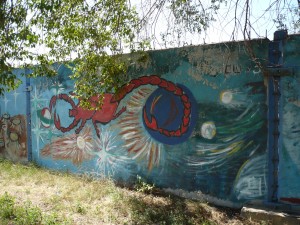
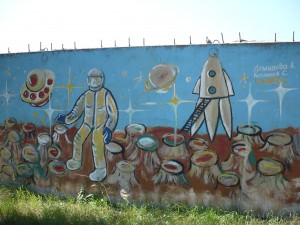
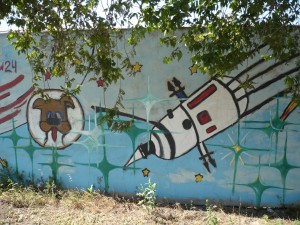
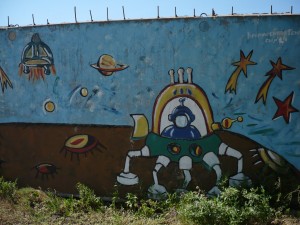
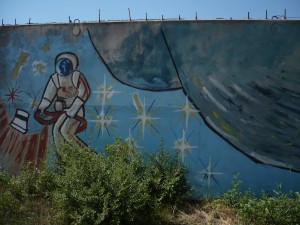
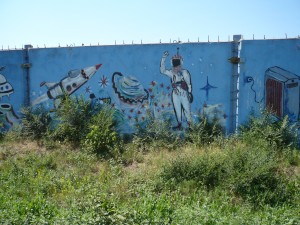

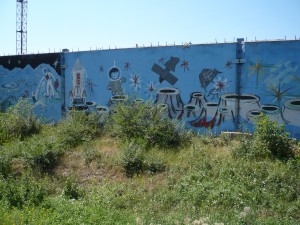

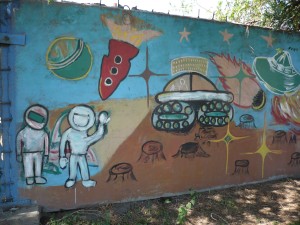

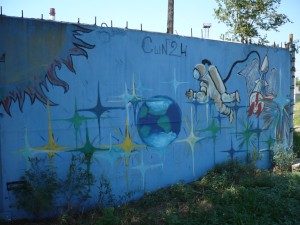
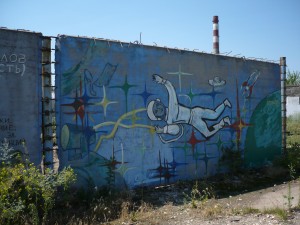


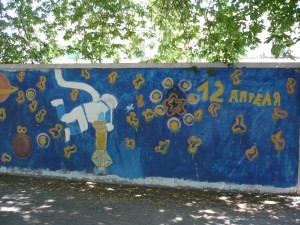

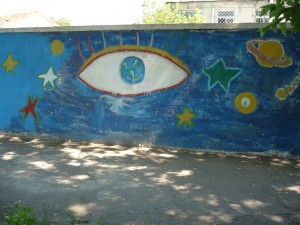
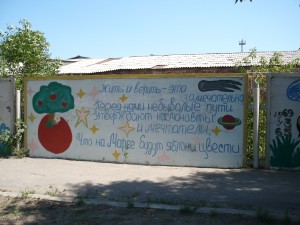
5 replies on “A Provincial Talisman”
From reading this, the one thing that stands out for me is a sense that in the provinces, time doesn’t move at the same speed. The reverence you describe seems to belong to an older, Soviet era. I wonder if the same could be said of other aspects of Russian provincial life, or if in your travels, you noticed more “Soviet” attitudes and ways of doing things that Moscow has long left behind.
I’ve always preferred to do my research in the Russian provinces –in part because I’m a provincial myself. My first book was on the peasant icon and lacquer box painters of Palekh, which allowed me to spend much of my time in Ivanovo archives and in the village itself. The pace of life is slower and various Soviet legacies therefore less visibly destroyed by the juggernaut of capitalist consumerism. Beyond that, however, the center-hinterland relationship seems to reflect the idea, common to European and American modernity in general, that authentic character somehow resides in the supposedly more traditional hinterland. That puts the province — and the heroic provincial — into a privileged position as the purveyor of the nation’s character and spirit.
Hi from Russia
It’s very interesting for me, a curious view…
I don’t know, whether Ekaterinburg is a provincial town or not (rather the sity), but here is a photo gallery of the ice sculptures created by artists on the eve of 2011 New Year holidays in a center of Ekaterinburg. The sculptures are devoted to the 50 th anniversary of the first man flight into space.
http://alek-morse.livejournal.com/40282.html
Andrew, I think I can see what you’re saying. Probably the closest analogy familiar to me would be America’s image of the cowboy, and the heroic Old West that never really existed except by bits and pieces, and even then, never quite as portrayed. It’s not as specific as the Russian attachment to Gagarin, but I think there’s still a definite, if subconscious, image of the rugged man from the wild country, keeping America clean and lawful. I’m not sure whether the center-hinterland relationship holds in the American aspect, though, or whether the mythology is so diffused at present as to make it moot whether one hails from Boston or Dodge.
I do notice that the American mythos diverges by embracing the idea of the heroic outlaw–think Shane–and I don’t seem to see that in the Soviet viewpoints. Older Russian stories, yes–some of them blustery and quite earthy. But the lives of Soviet heroes read almost like Orthodox hagiographies. The closest thing I see in today’s America is the reverence–make that worship–on the part of some military support non-profits and their members for the common soldier. So obviously it isn’t an exclusive Russian need to make a hero completely perfect, but–question here–why did the Soviet Union push so hard for the perfect image, even when doing so excluded any practical considerations?
****
Alexander, thank you for sharing the pictures–I enjoyed looking at them.
I spend a lot of time in Saratov. There are village schools named Gagarin across the province.